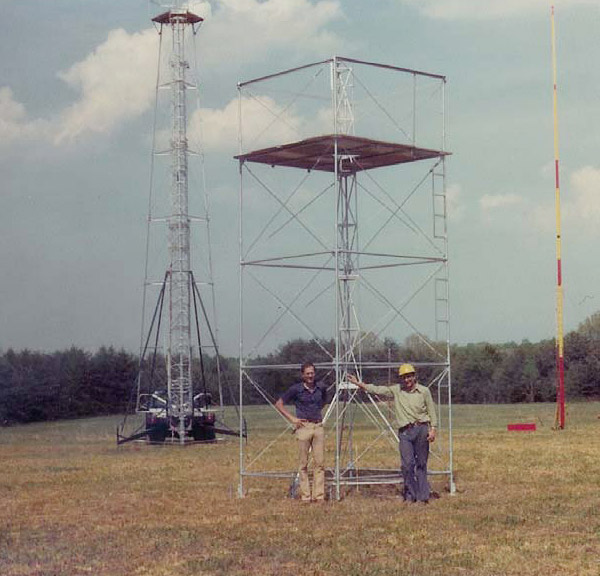Peck Tower
The Peck Tower, with its four vertical sides, was assembled by slipping pieces of steel pipe inside one another. Invented in approximately 1965, the tower was used through the 1970s.

This photo, taken in 1976, shows a Peck Tower in the foreground with the designer, Ralph Peckenpaugh, on the right. In the background are a Truck Mounted Observing Tower (left) and a Swedish Pole (right), two other types of towers highlighted in this collection.
The Peck Tower was designed by U.S. Coast and Geodetic Survey (C&GS) employee Ralph Peckenpaugh, in approximately 1965. Ten to twenty of the towers were constructed in the following years at the C&GS Instrument and Methodology Branch welding shop in Corbin, Virginia.
The Peck Tower was constructed of steel pipes, had four sides, and could be built in 10-foot increments. It was much easier and faster to build than a wooden tower of the same height. Each joint of the Peck Tower was held together by slipping one piece inside another and sliding a bolt through both pieces to hold the parts together. The tower was best used to heights of only 20 or 30 feet, since stability, with the tower's vertical sides, was decreased above these heights.
The Peck Tower was used on a triangulation project in Connecticut in 1978, and the entire tower, in parts, was carried through the woods to the site of the survey mark. A Peck Tower was used in this case because it was lighter than a Bilby Tower of the same height. After observations, the tower was found to have been pushed over the nearby cliff (evidently by vandals), making removal even more difficult!
- Tower shown: Peck Tower
- Approximate dates of use: 1960s – early 1980s
- Average heights: 20 to 30 feet
- Materials of construction: Steel
- Unique features: Four vertical sides; more quickly and easily assembled and transported than wooden counterparts.

 Timber Tower
Timber Tower Dimensional Lumber Tower
Dimensional Lumber Tower Pipe Tower
Pipe Tower Bilby Tower
Bilby Tower Peck Tower
Peck Tower Four-foot Stand
Four-foot Stand Truck Mounted Observing Tower
Truck Mounted Observing Tower G-Tower
G-Tower Trailer Mounted Tower
Trailer Mounted Tower Swedish Pole
Swedish Pole